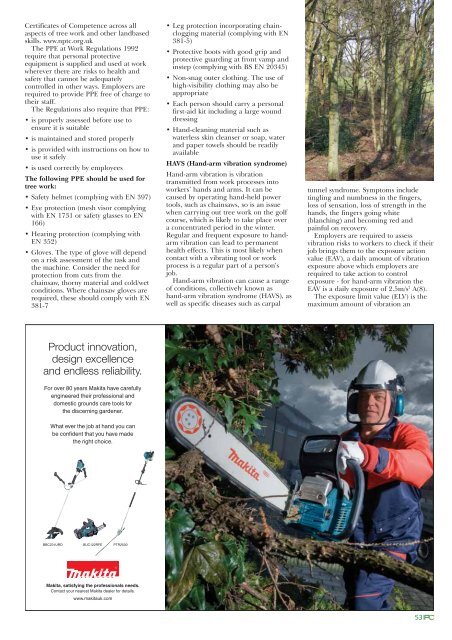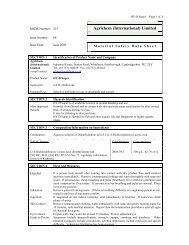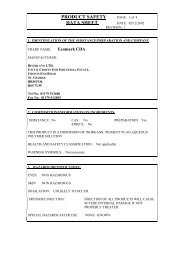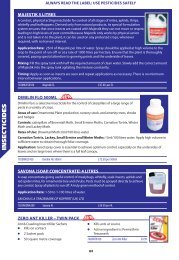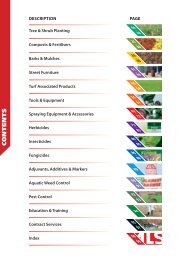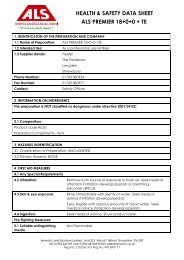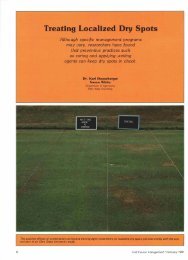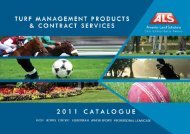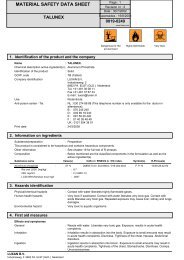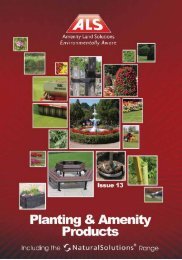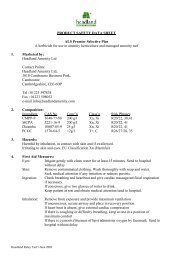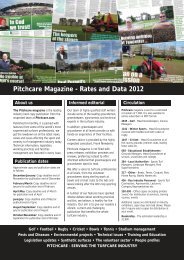Earning his Spurs - Pitchcare
Earning his Spurs - Pitchcare
Earning his Spurs - Pitchcare
You also want an ePaper? Increase the reach of your titles
YUMPU automatically turns print PDFs into web optimized ePapers that Google loves.
Certificates of Competence across all<br />
aspects of tree work and other landbased<br />
skills. www.nptc.org.uk<br />
The PPE at Work Regulations 1992<br />
require that personal protective<br />
equipment is supplied and used at work<br />
wherever there are risks to health and<br />
safety that cannot be adequately<br />
controlled in other ways. Employers are<br />
required to provide PPE free of charge to<br />
their staff.<br />
The Regulations also require that PPE:<br />
• is properly assessed before use to<br />
ensure it is suitable<br />
• is maintained and stored properly<br />
• is provided with instructions on how to<br />
use it safely<br />
• is used correctly by employees<br />
The following PPE should be used for<br />
tree work:<br />
• Safety helmet (complying with EN 397)<br />
• Eye protection (mesh visor complying<br />
with EN 1731 or safety glasses to EN<br />
166)<br />
• Hearing protection (complying with<br />
EN 352)<br />
• Gloves. The type of glove will depend<br />
on a risk assessment of the task and<br />
the machine. Consider the need for<br />
protection from cuts from the<br />
chainsaw, thorny material and cold/wet<br />
conditions. Where chainsaw gloves are<br />
required, these should comply with EN<br />
381-7<br />
Product innovation,<br />
design excellence<br />
and endless reliability.<br />
For over 80 years Makita have carefully<br />
engineered their professional and<br />
domestic grounds care tools for<br />
the discerning gardener.<br />
What ever the job at hand you can<br />
be confident that you have made<br />
the right choice.<br />
BBC231URD BUC122RFE PTR2500<br />
Makita, satisfying the professionals needs.<br />
Contact your nearest Makita dealer for details.<br />
www.makitauk.com<br />
• Leg protection incorporating chainclogging<br />
material (complying with EN<br />
381-5)<br />
• Protective boots with good grip and<br />
protective guarding at front vamp and<br />
instep (complying with BS EN 20345)<br />
• Non-snag outer clothing. The use of<br />
high-visibility clothing may also be<br />
appropriate<br />
• Each person should carry a personal<br />
first-aid kit including a large wound<br />
dressing<br />
• Hand-cleaning material such as<br />
waterless skin cleanser or soap, water<br />
and paper towels should be readily<br />
available<br />
HAVS (Hand-arm vibration syndrome)<br />
Hand-arm vibration is vibration<br />
transmitted from work processes into<br />
workers’ hands and arms. It can be<br />
caused by operating hand-held power<br />
tools, such as chainsaws, so is an issue<br />
when carrying out tree work on the golf<br />
course, which is likely to take place over<br />
a concentrated period in the winter.<br />
Regular and frequent exposure to handarm<br />
vibration can lead to permanent<br />
health effects. T<strong>his</strong> is most likely when<br />
contact with a vibrating tool or work<br />
process is a regular part of a person’s<br />
job.<br />
Hand-arm vibration can cause a range<br />
of conditions, collectively known as<br />
hand-arm vibration syndrome (HAVS), as<br />
well as specific diseases such as carpal<br />
tunnel syndrome. Symptoms include<br />
tingling and numbness in the fingers,<br />
loss of sensation, loss of strength in the<br />
hands, the fingers going white<br />
(blanching) and becoming red and<br />
painful on recovery.<br />
Employers are required to assess<br />
vibration risks to workers to check if their<br />
job brings them to the exposure action<br />
value (EAV), a daily amount of vibration<br />
exposure above which employers are<br />
required to take action to control<br />
exposure - for hand-arm vibration the<br />
EAV is a daily exposure of 2.5m/s 2 A(8).<br />
The exposure limit value (ELV) is the<br />
maximum amount of vibration an<br />
53


